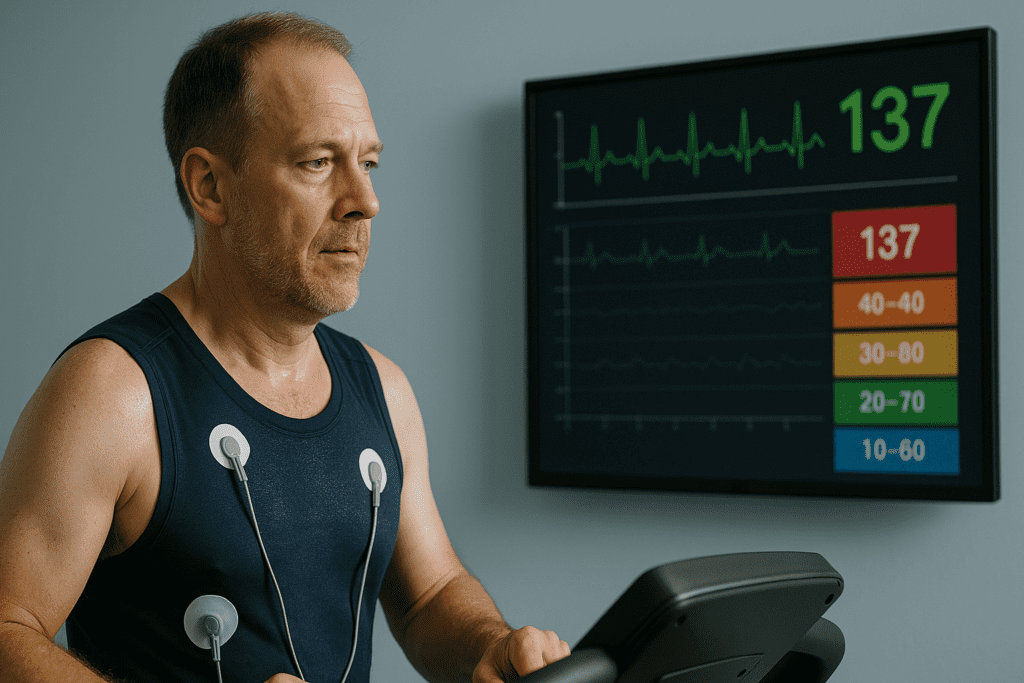Understanding Heart Rate Zones: The Foundation of Smarter Cardio Training
When it comes to cardiovascular fitness, many people rely on pace, distance, or calories burned as their primary metrics. However, these superficial markers often fail to reflect the true physiological demands of exercise. This is where understanding heart rate zones becomes essential. Heart rate zones, often referred to as cardio zones or HR zones, offer a far more precise and personalized method of tracking exercise intensity. By monitoring how hard your heart is working during physical activity, you can tailor your workouts to achieve specific fitness goals, whether it’s burning fat, building endurance, or increasing peak performance.
You may also like: Top Cardiologist-Approved Cardio Workouts to Improve Cardiovascular Fitness and Heart Health Naturally
The concept of heart rate training zones is rooted in well-established exercise physiology. These zones represent ranges of heart rate expressed as percentages of your maximum heart rate (max HR). By spending time in each of the five heart rate zones, you engage your body in different metabolic and cardiovascular processes. For example, zone 1 cardio typically involves low-intensity, recovery-focused activity, while zone 4 heart rate training emphasizes high-intensity anaerobic effort. The 5 heart rate zones model helps categorize workouts in a way that optimizes both safety and results.
To fully unlock the benefits of heart rate training zones, you first need to determine your personal max heart rate. This number is the upper limit of what your cardiovascular system can handle during exercise. While various formulas exist—such as subtracting your age from 220—the accuracy of these methods can vary widely. More advanced tools, including the most accurate heart rate zone calculator and lab-based VO2 max testing, offer a clearer picture. Fortunately, even a well-designed max heart rate calculator can provide a reliable starting point for most individuals.
The Science Behind Max Heart Rate: Why It Matters More Than You Think
Knowing your max heart rate is essential not just for calculating your heart rate zones, but for preventing overtraining and injury. Your max HR is not a one-size-fits-all number, and age-based formulas often fail to account for genetic, lifestyle, and health-related variables. For example, an elite endurance athlete in their 50s may have a higher max heart rate than a sedentary 30-year-old due to long-term cardiovascular conditioning.
Using a reliable max HR calculator is a great first step, especially when supported by wearable technology or clinical testing. Some calculators also offer a max HR rate calculator function that incorporates gender, resting heart rate, and activity level for greater precision. The data gained from these tools allows you to break your workouts into clearly defined training zones, each serving a specific physiological purpose.
This is particularly relevant in the management and prevention of cardiovascular disorders. Physicians increasingly recommend heart rate monitoring for patients recovering from heart surgery or managing chronic conditions like hypertension. Structured zone-based training enables safer rehabilitation by ensuring exercise remains within doctor-approved limits. This evidence-based approach is gaining traction in clinical settings, reflecting the broader movement toward precision medicine in cardiovascular care.
How to Determine Heart Rate Zones: A Personalized Approach to Training
Once you know your max heart rate, the next step is learning how to determine heart rate zones accurately. Each training zone corresponds to a specific percentage of your max HR, typically ranging from 50% to 100%. For example, zone 1 might range from 50% to 60%, while zone 5 could extend from 90% to 100%. These ranges vary slightly depending on the specific training methodology, but the principles remain consistent.
Several methods exist to determine your zones. Some athletes use lab-based lactate threshold testing or VO2 max assessments, which measure how efficiently your body uses oxygen. However, most recreational exercisers rely on heart rate monitors or online tools. Using a well-designed, most accurate heart rate zone calculator can guide you through this process, allowing for more tailored and effective training.
For runners in particular, understanding running zones can make a dramatic difference in training efficiency. Running heart rate zones help you avoid the all-too-common mistake of running every workout at a medium intensity. This “grey zone” approach often leads to stagnation and fatigue. By incorporating zone 2 cardio heart rate workouts into your weekly plan, you build a strong aerobic base without overtaxing your system. Meanwhile, intervals in zone 4 cardio push your anaerobic threshold, improving speed and power.

Unlocking the Benefits of Zone 2 Heart Rate Training
Among the five heart rate zones, none has garnered as much recent attention as zone 2 heart rate training. This range, typically 60% to 70% of max HR, is known for its unique ability to develop aerobic capacity without causing excessive fatigue. Zone 2 cardio heart rate training emphasizes fat metabolism, mitochondrial efficiency, and cardiovascular endurance—all without the muscle breakdown or cortisol spike often associated with high-intensity workouts.
Zone 2 training is particularly important for individuals managing cardiovascular disorders or returning from injury. Its low-intensity nature makes it safe and sustainable, while still offering robust improvements in VO2 max, stroke volume, and overall heart function. Physicians increasingly recommend zone 2 heart rate by age for patients seeking a structured, moderate approach to fitness. Since the optimal range varies with age, tools that help you find your specific zone 2 HR are invaluable for both safety and performance.
Elite athletes and beginners alike can benefit from incorporating more zone 2 workouts into their routines. Whether you’re cycling, swimming, or walking briskly, spending 30 to 60 minutes in your aerobic zone a few times per week can transform your cardiovascular health over time. Zone 2 hr monitoring has become a key metric in endurance coaching, thanks to its proven role in enhancing metabolic flexibility and heart efficiency.
The Role of Zone 3 and Zone 4 Training in Cardiovascular Fitness
While zone 2 training forms the aerobic foundation, zones 3 and 4 play a critical role in building speed, stamina, and competitive edge. Zone 3 cardio is often described as the “tempo zone,” representing roughly 70% to 80% of max HR. In this range, you begin to approach your lactate threshold—the point at which lactic acid starts accumulating in the bloodstream faster than it can be cleared.
Training in the zone 3 heart rate range helps improve your body’s ability to buffer lactate, extending the duration you can sustain harder efforts. This is especially valuable for runners, cyclists, and rowers looking to increase their time-trial or race performance. However, zone 3 training can be deceptively taxing, as it hovers just below high intensity. That’s why it should be balanced with adequate zone 2 cardio and recovery days to avoid overtraining.
Zone 4 training, on the other hand, is reserved for high-intensity intervals or threshold work. Operating at 80% to 90% of your max HR, zone 4 heart rate sessions push your anaerobic system to its limits. This stimulates gains in power output, neuromuscular coordination, and mental resilience. Zone 4 cardio also has a significant afterburn effect, increasing calorie burn for hours post-workout. For competitive athletes or those seeking significant performance improvements, zone 4 training is indispensable—but it must be used strategically, with proper rest and nutritional support.
How to Find Zone 2 Heart Rate and Use It for Long-Term Gains
Finding your personal zone 2 heart rate can be challenging, particularly without lab equipment. However, there are several methods to approximate it with confidence. The “talk test” is one of the simplest: during a zone 2 session, you should be able to speak in full sentences but not sing. This indicates that you’re working hard enough to benefit your cardiovascular system, but not so hard that you enter anaerobic territory.
More precise approaches involve using a max hr calculator to identify 60% to 70% of your maximum heart rate, then verifying this range with a heart rate monitor. Wearables such as chest straps or wrist-based sensors can help track real-time data, making it easier to stay within the appropriate zone. Some devices even offer built-in HR training zones that adapt dynamically as your fitness improves.
Learning how to work out heart rate zones and use them effectively requires patience, but the rewards are well worth it. Zone 2 training should not be seen as a fallback option or recovery-only tool. Instead, it forms the base upon which all other performance adaptations are built. Athletes from ultra-runners to rowers now spend the bulk of their training time in this range, emphasizing that longevity and resilience come from aerobic consistency rather than constant intensity.
Harnessing the Full Spectrum of Training Zones for Peak Cardiovascular Health
One of the most important aspects of heart rate training is recognizing that each of the five heart rate zones offers distinct physiological adaptations. Zone 1 cardio is perfect for recovery days and active rest, keeping blood circulating and promoting muscular repair. Zone 2 builds the endurance engine, improving aerobic efficiency and fat metabolism. Zone 3 sharpens your lactate threshold and tempo capacity, while zone 4 training enhances anaerobic power. Finally, zone 5—reserved for maximal efforts—improves sprint speed, neuromuscular control, and explosive power.
To get the most out of this spectrum, it’s vital to tailor your workouts across multiple zones depending on your goals and recovery status. Using tools like an exercise heart rate zones calculator or a training app can help you stay within target ranges. Many platforms now offer the ability to program workouts based on specific HR zones, providing audio and visual feedback during your session. These innovations allow for more strategic periodization and better overall fitness outcomes.
Cardio heart rate zones also offer important diagnostic value. Sudden changes in heart rate patterns—such as an unusually high heart rate at a low intensity—may signal overtraining, illness, or dehydration. Monitoring these patterns over time provides insight into how your body is adapting, helping you make informed decisions about training intensity, nutrition, and rest.

From Data to Results: Practical Applications for Heart Rate Training Zones
Understanding how to work out heart rate zones is only useful if you can apply this knowledge effectively in your day-to-day training. Begin by establishing a baseline with a max HR calculator, and cross-reference your results with age-based averages for additional context. Once your zones are identified, select a primary goal—such as improving aerobic fitness, increasing lactate threshold, or enhancing recovery capacity.
Start each week with a mix of low- and moderate-intensity workouts, spending significant time in your zone 2 HR range. Use zone 1 cardio for active recovery, especially following intense sessions. Incorporate zone 3 heart rate efforts once or twice per week to build tempo and stamina, and save zone 4 cardio for focused interval sessions. Over time, this balanced approach helps reduce injury risk, improve metabolic health, and increase training satisfaction.
Importantly, no single zone should dominate your entire training strategy. Variety is key not only for physiological adaptation but also for mental engagement. By embracing a full spectrum of HR training zones, you’ll ensure that each workout serves a specific purpose. This strategy has proven effective across multiple populations, from sedentary adults managing cardiovascular risk factors to elite athletes fine-tuning their race performance.
Frequently Asked Questions: Advanced Insights into Heart Rate Zone Training
1. What’s the best way to measure your heart rate zones if you’re over 60 or managing a cardiovascular condition?
For individuals over 60 or those with existing cardiovascular concerns, using the most accurate heart rate zone calculator is critical. Standard formulas like 220 minus your age may underestimate or overestimate your true max HR, particularly as heart function changes with age and health status. In these cases, a max heart rate calculator that incorporates resting heart rate, medication usage, and exercise history can offer a more precise result. Once you’ve identified your max HR, using zone 2 heart rate by age becomes essential for building safe aerobic capacity without overexertion. It’s also wise to verify your cardio heart rate zones through a supervised stress test or with input from a cardiologist if you’re under clinical care.
2. Why do some people struggle to stay in zone 2 cardio heart rate during low-intensity exercise?
Staying within your target zone 2 HR can be surprisingly difficult, especially for those who are newer to structured training. This zone feels deceptively easy, which often causes people to unconsciously exceed it, especially during running zones. If you find yourself creeping into zone 3 cardio despite light effort, it may be due to low aerobic efficiency or poor pacing habits. To improve control, use a heart rate monitor with real-time alerts and practice exercises like brisk walking or incline treadmill work. Over time, your ability to sustain longer durations within zone 2 cardio heart rate will improve, helping you maximize fat metabolism and aerobic training zone heart rate benefits.
3. Can heart rate training zones help with weight loss and metabolic health in addition to performance?
Yes, heart rate training zones can be a powerful tool for weight loss and metabolic optimization, particularly when you focus on zone 2 training. Zone 2 heart rate is often referred to as the “fat-burning zone” because it enhances mitochondrial function and encourages fat oxidation at a cellular level. Spending 45 to 60 minutes in this zone several times a week improves insulin sensitivity and metabolic flexibility—two key components of long-term weight regulation. Using an HR training zones approach, you can also rotate in higher-intensity efforts within zone 4 training to stimulate hormonal responses that support lean muscle development. The result is a well-rounded metabolic strategy that outperforms calorie tracking alone.
4. How does psychological stress impact exercise heart rate zones and training effectiveness?
Psychological stress can significantly skew your heart rate, sometimes causing a noticeable shift in your HR zones even before you begin exercising. Elevated cortisol levels and autonomic nervous system activation may push your heart rate higher at rest, making it easier to enter zone 3 or zone 4 cardio even with minimal effort. This disrupts the intended benefit of lower-intensity training and can impair aerobic development if it becomes chronic. To mitigate this, incorporate mindfulness techniques, controlled breathing, or low-intensity zone 1 cardio warmups before higher-effort sessions. Over time, these strategies help recalibrate your response to training and improve your ability to stay within your target heart rate training zones.
5. What role do wearable fitness trackers play in determining heart rate zones accurately?
Wearable devices have revolutionized how we approach heart rate monitoring, but their accuracy can vary. Wrist-based sensors often overestimate or lag during sudden changes, which may misclassify your actual HR zones. For the most precise data, especially when you’re learning how to determine heart rate zones, opt for a chest strap monitor paired with a training app. This combination offers better real-time feedback and can be used with the most accurate heart rate zone calculator platforms to fine-tune your training zones. Many apps now dynamically update your zones based on ongoing performance, recovery trends, and even sleep data, giving you a comprehensive view of your cardio zones progression.
6. How can zone 3 heart rate training improve mental focus and athletic resilience?
Zone 3 heart rate training often goes unrecognized for its mental conditioning benefits. Unlike the calming nature of zone 2 hr workouts, zone 3 demands sustained concentration, pacing, and effort management—skills that are crucial in competitive sports and high-performance scenarios. This tempo zone pushes both your mind and body to perform under extended stress, improving resilience to discomfort and fatigue. Integrating running heart rate zones that include consistent time in zone 3 helps athletes develop a “gear” for endurance races or long-duration events. When used alongside zone 1 cardio recovery, this approach promotes both neurological and muscular adaptation.
7. Are training zones relevant for non-athletes or people who don’t exercise regularly?
Absolutely. Even sedentary individuals or those new to fitness can benefit greatly from learning how to work out heart rate zones correctly. In fact, for beginners, heart rate training zones can offer a safe and structured pathway toward improved cardiovascular health. For instance, staying within zone 1 cardio or lower zone 2 ranges provides a non-intimidating entry point that reduces joint strain while enhancing circulation and stamina. A basic max hr calculator can help you create a personalized roadmap that feels achievable. This method empowers non-athletes to train with intention, tracking progress without focusing solely on aesthetic outcomes like weight or appearance.
8. How often should I recalculate my max heart rate and adjust my hr zones?
Heart rate zones aren’t static—they evolve with age, fitness level, and lifestyle changes. You should reevaluate your max HR using a reliable max hr rate calculator every 6 to 12 months, or sooner if you notice significant performance changes. As your cardiovascular system adapts, you may find that your zone 2 hr becomes easier to maintain, or that zone 4 heart rate efforts take longer to reach. Regular testing ensures that your training zones continue to reflect your current capacity rather than outdated assumptions. Many training platforms allow for ongoing updates using performance data, creating a dynamic model that reflects real-time changes in aerobic and anaerobic thresholds.
9. How can you use heart rate zones to prevent overtraining or burnout?
One of the most effective ways to avoid burnout is by cycling your effort across the 5 heart rate zones strategically. Overtraining often results from excessive time spent in mid-to-high-intensity HR zones without adequate recovery in the aerobic zone. By using a well-balanced training plan that prioritizes zone 2 cardio heart rate on most days and limits zone 4 training to once or twice per week, you create a system that promotes recovery and avoids physiological overload. Monitoring heart rate variability (HRV) alongside training zones can also give you early warning signs of fatigue. Integrating rest days or switching to zone 1 cardio when recovery is needed will ultimately improve consistency and long-term results.
10. Are there professional tools that go beyond standard calculators for athletes seeking performance optimization?
Yes, advanced athletes often use laboratory-grade tools or professional coaching platforms to achieve pinpoint accuracy in their hr training zones. While a typical max heart rate calculator is useful, it lacks the nuance required for elite training. Tools like lactate threshold testing, gas exchange analysis, and metabolic carts allow for the calibration of personalized training zones based on real-time physiological markers. These tools also offer a granular look at aerobic training zone heart rate thresholds, making it easier to optimize interval structure, recovery duration, and fueling strategies. For endurance athletes, fine-tuning running zones to this level often results in substantial performance gains with lower injury risk.

Conclusion: Why Heart Rate Zone Training Is the Smarter Way to Cardio
In a world saturated with fitness fads and quick-fix programs, heart rate zone training offers a refreshingly science-backed approach to long-term cardiovascular health. By learning how to determine heart rate zones accurately and integrating them into your routine, you gain access to a powerful tool for personalizing exercise, optimizing recovery, and reaching your goals efficiently. Whether you’re trying to improve endurance, lose weight, or recover from heart-related illness, understanding and using your heart rate zones provides the guidance you need to train smarter—not just harder.
Zone 2 heart rate training, in particular, stands out as an underrated but incredibly effective method for improving aerobic function and cardiovascular resilience. When paired with strategic use of zone 3, zone 4 training, and recovery sessions, it becomes part of a holistic system that supports both performance and well-being. With tools like the most accurate heart rate zone calculator and wearable monitors, you can easily tailor workouts to your current fitness level, age, and health status.
As more evidence emerges supporting the clinical and athletic benefits of heart rate training zones, it’s clear that this method is more than just a performance enhancer—it’s a preventive and rehabilitative asset for cardiovascular health. The key lies in using it intentionally and consistently. Whether you’re an athlete seeking peak conditioning or a patient working to manage a heart condition, applying the principles of HR zones and zone-specific cardio is one of the most effective, accessible, and sustainable choices you can make for your heart.
cardiovascular endurance training, aerobic fitness strategies, personalized workout plans, heart rate monitor tips, endurance sports conditioning, smart cardio workouts, fitness tracking devices, improving aerobic efficiency, low intensity steady state cardio, effective fat-burning workouts, high performance fitness training, VO2 max improvement, wearable health tech, training recovery techniques, tempo running strategies, exercise intensity control, optimizing athletic performance, cardiovascular health programs, lactate threshold training, precision fitness planning
Further Reading:
Understanding Heart Rate Zones for Effective Workouts
What to Know: Heart Rate for Fat-Burning Vs. Cardio
Disclaimer
The information contained in this article is provided for general informational purposes only and is not intended to serve as medical, legal, or professional advice. While MedNewsPedia strives to present accurate, up-to-date, and reliable content, no warranty or guarantee, expressed or implied, is made regarding the completeness, accuracy, or adequacy of the information provided. Readers are strongly advised to seek the guidance of a qualified healthcare provider or other relevant professionals before acting on any information contained in this article. MedNewsPedia, its authors, editors, and contributors expressly disclaim any liability for any damages, losses, or consequences arising directly or indirectly from the use, interpretation, or reliance on any information presented herein. The views and opinions expressed in this article are those of the author(s) and do not necessarily reflect the official policies or positions of MedNewsPedia.


